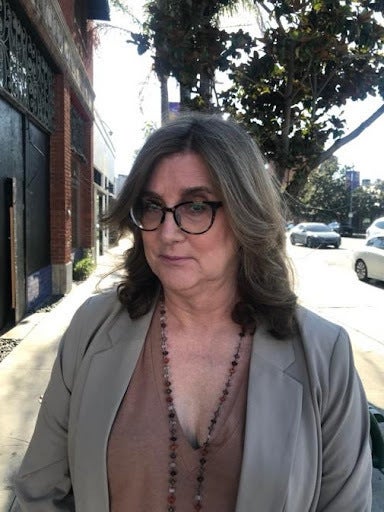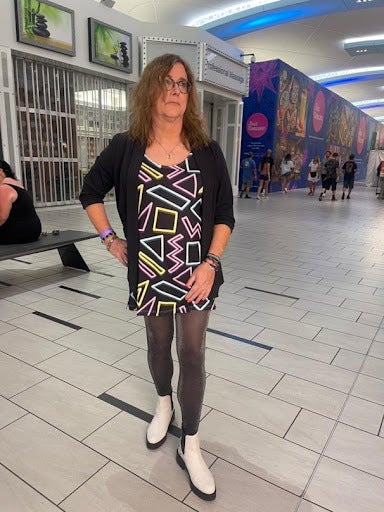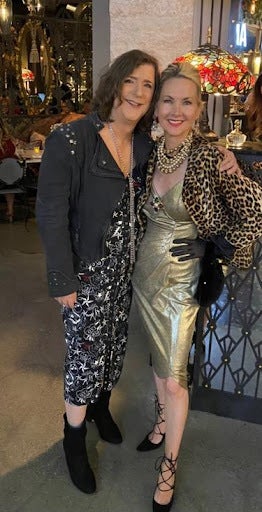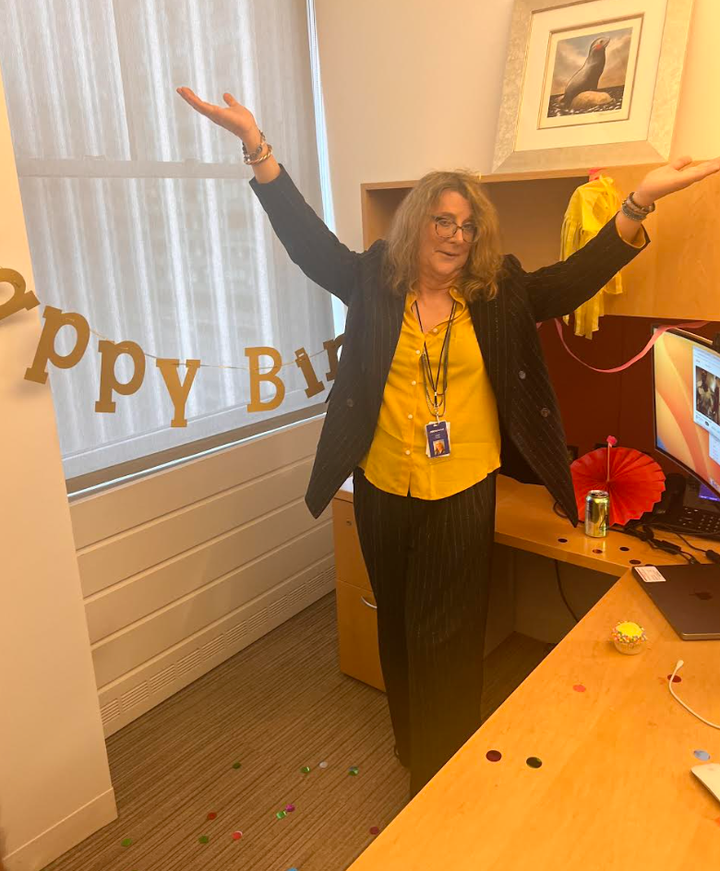
I never thought I’d be here. And yet just a few months ago, at the age of 63, I came out as a transgender woman.
First of all, I’m well aware there’s a cultural expectation in America that once you hit the age where 401(k)s become reality rather than theory, the most exciting experience you have left is seeing which closes up first — your arteries or your mind. This is supposed to be the time to start thinking about endings, not beginnings. Given all that, I realize how unlikely it is that anyone would take on perhaps the biggest do-over there is: gender transition.
Even worse, I’m doing this at a particularly treacherous time, when far too many presidential candidates and groups with words like “liberty” and “freedom” in their names have turned people like me into their political piñatas. To them, we’re just trying this out for some perverse thrill. However, being trans isn’t like experimenting with bangs. It’s not something you dabble with and then grow out of. It’s a feeling we’ve spent a lifetime trying to ignore until we either die fearful and silent, or decide that living whole and happy is worth having people hate us.
I’ve been trying to figure out which choice to make since I was 7 or 8 and had a recurring dream where Tabitha from ”Bewitched” would ask to hang out with me. I just had to eat this pudding-like stuff in a little paper cup first. I complied and suddenly I was a little girl, and we went off to play.
A few years later I started having another dream, in which I’d grow breasts that gave me the ability to fly. Then there was the dream where I felt super itchy and when I scratched myself, my skin peeled off to reveal that I looked just like Olivia Newton-John.
At the time, I didn’t question these dreams. I just woke up feeling complete and content, right up until I got a little bit older and learned to hate myself with the heat of a thousand suns because there was no way I was a girl. I tried to fall in line and go along with what society told me: Of course we’re the private parts we’re born with. Of course gender dysphoria means I am a satanic groomer pedophile. Of course trans women are just gay boys who yearned to play with dolls and wear their moms’ dresses, and trans men had pushy dads who made them watch football and fix carburetors. Facts are facts, right?
Then along came puberty, which made things even more complex. While other boys in junior high were lusting after models in the Sports Illustrated swimsuit issue, I was seriously depressed by seeing those beautiful women in soaking wet bikinis that I’d never get to wear.
I figured I could fix the problem by stealing my mom’s birth control pills. I swallowed one but instead of experiencing some magical transformation, I threw it right back up. At another point, I ordered a makeup kit from one of my mom’s magazines. This was a plan I hadn’t thoroughly thought through because when it arrived, she asked why this was sent to me and I said it was probably just a prank played by some bully.
I couldn’t tell her what was really going on. Our family was one of those legendarily stolid Midwestern types — the “life is to be endured and not enjoyed,” “God never makes a mistake so just keep quiet” kind. Plus, since we moved to three different cities during my four years of high school, I had no close friends to open up to.

This isolation did provide one advantage: Wherever we lived, I’d end up hanging out at the local library, searching for any book or magazine article to explain this disconnect between my body and my soul. The good news? Throughout history, others had felt the same way. The bad news? I read that what I was feeling was an illusion — a mental illness that I needed to be talked out of.
I developed severe insomnia no doctor could cure, leaving me praying every night that aliens would blow up the Earth so I wouldn’t have to worry about these “transsexual” thoughts. Suicide was a sin and not an option, so ignoring these feelings was the only choice.
Then I discovered Christine Jorgensen, the first trans woman to become a U.S. media sensation back in the early 1950s. I wrote her a letter explaining the blame and shame that came with this incongruity between how the world saw me and how I saw myself. Three weeks later, I got a note from her assuring me I wasn’t a freak and I had to trust my feelings. She also included a signed copy of her autobiography, which I hid under my pillow to read and reread for years afterward.
Despite blips of contentment — like the time I won a women’s Fleetwood Mac “Rumours” T-shirt in a radio show contest and proudly wore it to school, even though I was mocked mercilessly — I tried to just live with the self-loathing brought on by my inescapable feminine feelings.
At one point, I worked up the nerve to see a counselor at the local gay and lesbian center, where I was told that a) I sounded like a classic case of transsexualism and b) I was 17 so there was nothing anyone could do to help me. Naturally, I focused on the latter information to justify burying all trans thoughts. I replaced them with whatever testosterone-fueled activities I could think of — finding a girlfriend to move in with, talking nonstop sports over beers and playing Pac-Man for hours with dude buddies, never having a deep conversation with anyone, and refusing to ever ask for directions.
That resolve lasted until I turned 21, when I went to a therapist who took less than 50 minutes to tell me what I didn’t want to hear: I was as trans as any patient he’d ever seen. He sent me to a doctor, who started me on a small dose of estrogen to see if it helped my worsening depression. It did. The funny thing about finally getting what I’d always wanted, though, was that my “endure” instinct kicked “enjoy” to the curb, and I flushed away my sanity-saving hormones to stop all that nonsense.
For most of the next four decades, I focused on finding success as journalist and producer. I got married. We had two kids. I made it a point to attend every baseball game or school play that I possibly could. I worked hard to make male friends to hang out with. Still, the dysphoria rattled around like my brain was a pinball machine.

After divorcing, I’d occasionally tiptoe right up to the transition line. I’d find a new therapist and start hormones again — and then panic and stop. I taught a writing class for older trans women at the Los Angeles LGBT Center’s Trans Lounge. I began following every popular trans woman I could find on social media to pretend I had a community.
My internal transphobia, however, was like “Working for the Weekend” at a Loverboy concert: inevitable. Every step toward transition was quickly followed by an equal and opposite attempt at dude-ing things up. I had my doctor prescribe testosterone patches. I had liposuction to remove any trace of the “man boobs” that estrogen had given me. I became a dating machine on Match.com, even though most of those coffee dates ended with women telling me that while I seemed nice enough, I also appeared to be holding back a big piece of myself.
I had become resigned to living the rest of my life as if it belonged to someone I emailed with a few times but never actually met, but then came an unexpected 12-month span that turned everything around. My son had graduated from college and my daughter had just started, so they had clearly moved on with their lives. I discovered home movies of my biological dad, who had died before I was born so I’d never seen anything but some photos of him. I turned 60. And there was a pandemic, which brought with it endless hours of isolation and contemplation.
When all of this collided, the desire to finally take care of myself was hard to ignore. I knew I needed to accept my transness and let others in on the secret, or die enduring without enjoying. So I sought out help.
I’m a producer for a daytime television talk show. As I began debating whether to start estrogen again, I happened to be working with Sharon Stone. Two weeks after we spoke at length about the importance of living authentically and without regret — something she’s done better than almost anyone else — I restarted hormone therapy and never looked back.
When I felt ready to feminize my wardrobe, I went online and discovered a company that helps trans people find their true selves through their fashion choices. Although it took me six months from our initial contact to our first shopping trip, company owner Annaliese Cherry was so warm and encouraging that she convinced me to do something I never thought I’d dare to: go with her to Las Vegas for my first experience wearing a dress in public.
When it was time to confront my greatest fear — telling my 20-something-year-old children about my transness — they weren’t fazed at all. I should have known their generation is far more willing to let people just live as themselves.
As I prepared to start the coming-out process at work, I confessed everything to Robert Ramos, the hairstylist for our show’s host. His boundless enthusiasm upon hearing my news — not to mention the amazing haircut and highlights he gave me — showed me that self-esteem might actually live up to the hype.

When I wanted to introduce Caragh — the new name I chose for myself because it means “beloved” in Gaelic — to the rest of the staff at our season-ending party, their support was immediate and endless. Nearly everyone asked for my pronouns and how to pronounce my name. Our empathic host told me how hot my legs were. After years of fearing the reactions I’d get, telling people I was trans turned out to be as traumatic as revealing that blue was now my favorite color.
I’m blessed to live in a place and work in an industry where trans allies exist, but my new life is far from perfect. If I see someone staring and laughing when I’m in public, I slink away because I worry that I look like my grandpa wearing Betsey Johnson. As I doomscroll through stories about trans hate in America, fueled by those who’ve most likely never actually spoken to a trans person, I cry and yell and start plotting how to fit back in that closet.
Then, in the thick of all that darkness, I’ll get ma’am-ed at the gym. Or a total stranger at the grocery story says my outfit makes me the coolest chick there. Or I make devoted new friends like Amy and Kathryn, who never met Previous Me. These experiences make it clear that transitioning has never been about “switching genders.” Instead, it’s really about finally experiencing self-worth, taking the lead in my life instead of watching it from the mezzanine, and not only trusting others with my story but also trusting myself — none of which I ever expected to do at 63.
I suppose I should thank all those saying things like “for the good of society ... transgenderism must be eradicated from public life,” or that parents of trans kids should be “shot in the back of the head ... and then we can string them up above a bridge.” Truth be told, it was their rhetoric that ultimately pushed me into coming out, because I just couldn’t let their grandstanding continue to demonize people like me.
Even though I’m at the age where my skin starts to sag and wrinkle, it’s also the age where it’s become much thicker when it comes to such bullying. Once you’re past 60, your internal “fuck counter” hits zero, so I have none left to give. I don’t have time to waste worrying about what others think of me. I only have time to let others see that it’s never too late to be who you’ve always wanted to be.
It’s taken so long for me to find my path, but now that I have, walking along it appears to suit me. Recently, I had drinks with some friends I hadn’t seen for a while. After a couple of minutes, one of them stared at me, waving her hands in my direction, and said, “This just feels right.” That was a phrase I honestly never thought I’d hear. Now that I’m here, and it isn’t merely a dream, I just hope it’s not too late to set up that playdate with Tabitha.

Caragh Donley is no longer hiding her age, so it’s safe to reveal she’s been at this writing thing a long time, working for outlets including People magazine, TV Guide, The New York Times, the Los Angeles Times, The Boston Globe, Emmy Magazine and Vanity Fair. She’s the author of “The Can’t-idates: Running for President When Nobody Knows Your Name.” In addition to her print work, she’s worked as a producer on shows including VH1’s “Behind the Music,” “The Queen Latifah Show” and “The Martin Short Show.” She is currently a senior producer with “The Kelly Clarkson Show.”
Do you have a compelling personal story you’d like to see published on HuffPost? Find out what we’re looking for here and send us a pitch.
